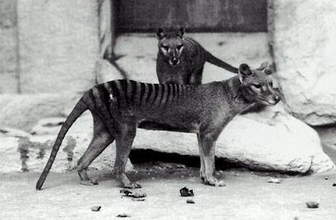 |
usa | world | animals | vocabulary | health | science | math | history |
Tasmanian Tiger
The Thylacine (Thylacinus cynocephalus), formerly known as the Tasmanian Tiger or the Tasmanian Wolf, was a large carnivorous marsupial native to Australia. Although just one of many Australian mammals to have become extinct following European settlement of the continent, it is the largest and by far the most famous.
Like the tigers and wolves of other continents (both unrelated placental carnivores), the Thylacine was a top-level predator, and in size and general form quite closely resembled the Northern Hemisphere predators it was originally named after.

In late Pleistocene and early Holocene times, the Thylacine was widespread on the mainland. After traders from the islands to the north of the continent introduced the Dingo about five thousand years ago, the Thylacine was unable to compete and the population dwindled. It is uncertain when the last mainland Thylacine died, but it may not have been until perhaps a thousand years or so ago.
In outward appearance, the Thylacine resembled a large, short-haired dog with a stiff tail, which smoothly extended from the body like that of a kangaroo. It was about 100 to 130 cm long including its tail of about 50 to 65 cm., and had an amazingly large gape. It was a yellowish-brown in colour with 16 to 18 dark stripes on its back and rump, hence its common name: "Tasmanian tiger." The Thylacine's pouch opened to the rear of its body. The structure of the thylacine spine undergoes a sudden transition about halfway along the body.
The extinct Thylacine at Melbourne Museum, a work of taxidermyIn Tasmania, where there were no Dingos, the Thylacine survived until the 1930s before persecution by farmers, government-funded bounty hunters and, in the final years, collectors for overseas museums saw it wiped out. The last confirmed wild Thylacine sighting was in 1932, and the last captive, named Benjamin, died in the Hobart Zoo on September 6,1936. A short black and white film was made of the captive pacing back and forth in its enclosure.
Although there is no reasonable doubt that the Thylacine is extinct, sightings are still occasionally claimed, both in Tasmania and other parts of Australia.
In February 2005, a German tourist claimed to have taken digital photographs of a Thylacine, but the authenticity of the photographs has not been established.

In March 2005, Australian news magazine The Bulletin, as part of its 125th anniversary, offered a $1.25 million reward for the safe capture of a live Thylacine. The prize offer closes at the end of June 2005. An offer of $1.75 million was subsequently offered by a Tasmanian tour operator, Stewart Malcolm. No successful claims have been made.
The Australian Museum in Sydney began a project in 1999 reminiscent of the science fiction movie Jurassic Park. The goal is to use genetic material from specimens taken and preserved in the early 20th century to clone new individuals and revive the species from extinction. In late 2002 the researchers had some success as they were able to extract usable DNA from the specimens. On February 15, 2005, the museum announced that it was stopping the project after tests showed the specimens' DNA had been too badly degraded by the (ethanol) preservative.
In May 2005, Professor Mike Archer, the University of New South Wales' Dean of Science and former director of the Australian Museum, announced that the project was being restarted by a group of interested universities and a research institute.
This article is licensed under the GNU Free Documentation License. It uses material from the Wikipedia article "Tasmanian Tiger".